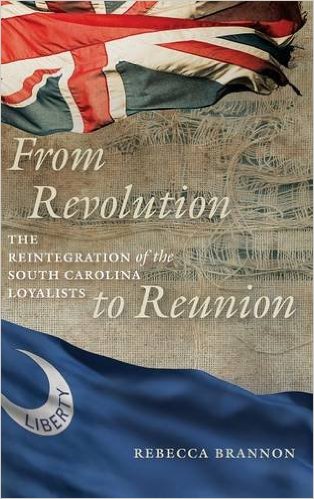Rebecca Brannon. From Revolution to Reunion: The Reintegration of the South Carolina Loyalists. (Columbia, SC: University of South Carolina Press, 2016).
By Carole Watterson Troxler
Rebecca Brannon (James Madison University), has distilled a well-researched 2007 dissertation of about 500 pages to a cogency deserving close attention from students of the American Revolutionary Era. Her breezy essay style delivers rapid-fire insights to engage readers and stimulate further examination of little-explored elements of American nation building. The use of secondary sources is selective and less critical than it might be but generally appropriate for her purpose: to understand the rapidity, success, and meaning of the reintegration into South Carolina social and political life of seventy percent of the 232 men proscribed in the 1782 Confiscation Act, and that within a mere two years. Most of the others were absentees or British merchants. The study is limited to 1782-1784 and is not concerned to treat Lowcountry and Upcountry loyalists equally, because the study is based on actions of the legislature, where Lowcountry concerns were paramount. Court action was not part of the machinery for dealing with loyalists in South Carolina. County courts organized after 1785 legislation created twenty new interior counties.

Rebecca Brannon, From Revolution to Reunion: The Reintegration of the South Carolina Loyalists
Brannon credits the successful reintegration of proscribed men primarily to the efforts of the men themselves, whose wartime actions against the revolutionary cause varied considerably. Individually they petitioned the state legislature for relief from confiscation and fines, after preparing their ground with neighbours with whom they shared a continuing relationship and often family ties. She stresses the psychological effectiveness of their humble apologies (which avoided admitting any ill deeds). Crucially, revolutionary co-signers and supporters demonstrated a widespread local willingness to continue mutually beneficial pre-war community relationships. Beyond the petitions themselves, Brannon draws from careful readings of correspondence among the petitioners and the legislators.
She credits Adeanus Burke, John F. Grimke, and Christopher Gadsden for effective public pronouncements in favour of clemency for loyalists, as they were unimpeachable revolutionaries. Burke in particular traveled through the backcountry to convince “middling sorts” of the value of reintegrating loyalists. A recent arrival, he could rise above accusations of backscratching among the elite. Using his position as circuit judge, he urged amnesty to keep loyalists from troublesome behaviour and to maintain the legal equality of white citizens. Brannon notes the effectiveness of newspapers in spreading such arguments, claiming “80 percent of rural white South Carolinians could read” (107).
It would be easy to assess the reintegration as a mere closing of the ranks of the Lowcountry elite, from whom nearly all named confiscations were drawn. Concerns to defend slavery as well as family fortunes always loom (and would be striking after the importation of slaves became illegal and exiles from South Carolina successfully asked to return from the Bahamas and the Caribbean and bring their “large families” for sale). More than once, Brannon acknowledges the relevancy of these realities and admits that class solidarity helps to make reconciliation understandable. She digs deeper, however, apparently in an attempt to wring something of nation-building value from the South Carolina experience.
Throughout the state, Brannon suggests that self-selected men boosted their own local authority as they reinforced that of the legislature and the state in general. Their early rhetoric of revenge satisfied public necessity but gave way to pragmatic clemency. The would-be leading men in the Upcountry wanted the same circumstances as their Lowcountry brethren who controlled the state. The author’s fullest attention to issues in the interior centers on the large Cunningham family, whose members displayed a broad spectrum of loyalist behaviour, perception, and legacy. With fuller documentation than most Upcountry loyalist figures, the Cunninghams yield fruitful material for Brannon’s exploration of the disappearance of a loyalist presence in publicly remembered history of the American Revolution. Ultimately, she suggests, loyalists were reintegrated so successfully into the new republic that public history bypasses them altogether, a lingering challenge for scholars who wish to understand what really happened during and after the American Revolution, beyond South Carolina and the United States.
Readers with interests in family and migration history in Atlantic Canada will find indirect but useful context. The issues Brannon presents will help to clarify how some loyalists might have expected to return to the southern backcountry, either permanently or to bring out family members, following a period of exile in New Brunswick or Nova Scotia. Far from a broad brush of clemency and forgetfulness, however, returnees encountered dynamics that turned on local power and preexisting relationships.
Carole Watterson Troxler, Professor Emerita, Elon University, studies the impacts of the American Revolution in the southern backcountry, maritime Canada, and the Bahamas. Twenty-plus articles feature white and black “loyalist” persons, settlements, and themes. Her latest book is Farming Dissenters: The Regulator Movement in North Carolina, which won the Christopher Crittenden Award in 2010.




Pingback: Canadian History Roundup – Week of March 5, 2017 | Unwritten Histories